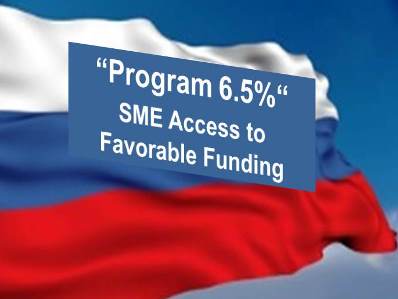 «Program 6.5%». The Russian Corporation for the Development of Small and Medium Sized Businesses launched, in 2015, a funding program in association with 31 banks. The program entails the provision of funding in the range of US$ 175,000 to US$ 17,500,000 at an interest rate of 10.6% for small businesses and 9.6% for medium businesses. This compares favorably with current interest rates charged by banks of 14% and 13% respectively. Authorized banks receive funding for this program from the Bank of Russia at an annual interest rate of 6.5%. The program runs for the duration of three years. The program supports high-tech and import substituting projects from eight industries (health care, agriculture, manufacturing, construction, etc.). Other sectors are excluded. Approximately 90% of funding was provided by three state-owned banks: VTB, Sberbank and the Russian Agricultural Bank.
«Program 6.5%». The Russian Corporation for the Development of Small and Medium Sized Businesses launched, in 2015, a funding program in association with 31 banks. The program entails the provision of funding in the range of US$ 175,000 to US$ 17,500,000 at an interest rate of 10.6% for small businesses and 9.6% for medium businesses. This compares favorably with current interest rates charged by banks of 14% and 13% respectively. Authorized banks receive funding for this program from the Bank of Russia at an annual interest rate of 6.5%. The program runs for the duration of three years. The program supports high-tech and import substituting projects from eight industries (health care, agriculture, manufacturing, construction, etc.). Other sectors are excluded. Approximately 90% of funding was provided by three state-owned banks: VTB, Sberbank and the Russian Agricultural Bank.
In February Vice-minister Dmitry Medvedev stated that the program should be prolonged in view of the excellent results (so far two thirds of the approved funding was taken up) and due to the fact that it is highly appreciated by banks and entrepreneurs. The extended program will include funding up to US$87,500 for micro-companies. As of July1st funding limits will be raised and regional banks will be joining the program with the aim to reach a greater number of SMEs.
Information transparency is a crucial issue: According to market experts the decision to prolong “program 6.5%” was correct and commendable. Nevertheless they stress the fact that success depended on the selectiveness and term limitations. Usually the SME business sector is hamstrung by exorbitant interest rates, plus the complexity of long-term borrowing and struggle to repay loans. Currently it is much easier to obtain funding from a micro-finance company at 25 to 30% interest than wasting time and expenses to meet the requirements of larger banks.
Usually banks have a low level of risk appetite to fund small and medium-sized businesses. The main reason is the relatively high level of loan defaults and the low margin to cover credit risk and expenses. Adding to this is the relatively high cost of risk assessment of an applicant due to the lack of transparency (lack of accurate, reliable and timely financial information). Under such a scenario a bank would have to substantially improve the quality of its loan portfolio in order to be able to cut interest rates.
Improving transparency: Under the circumstances banks and the SME sector should co-operate by creating an SME credit bureau (information sharing), supported by utilizing alternative data sources and analytics to eliminate current information asymmetries and to reduce the cost of risk assessment.
 The Information and Analytical system Globas-i® https://globas.credinform.ru/en-GB/home/auth can assist in credit risk assessment of Russian counterparties including the SME sector.
The Information and Analytical system Globas-i® https://globas.credinform.ru/en-GB/home/auth can assist in credit risk assessment of Russian counterparties including the SME sector.
Source: Credinform Russia























Trackbacks/Pingbacks